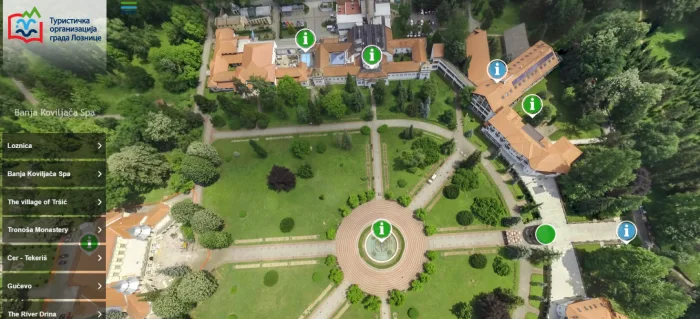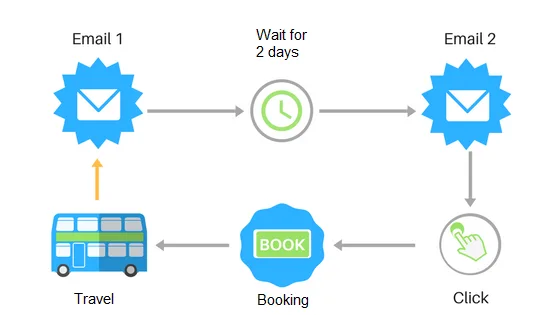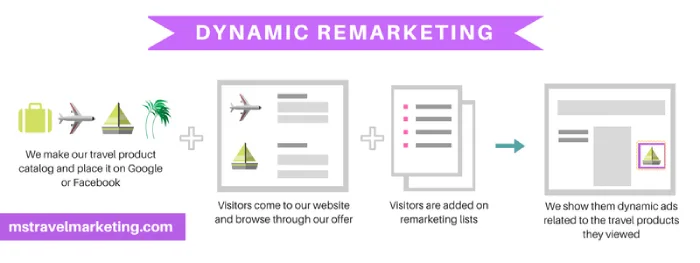The last months of the year are the right time to slowly summarize your business results and create a digital travel marketing strategy for the next year.
If you’ve been thinking about what would be good to apply next year to attract more tourists at a lower price, then it will surely be useful for you to know the key things that will present the crucial difference in market competition in favor of those who apply them.
What is digital marketing in tourism and why is it important?
Digital tourism marketing includes a set of different marketing activities that rely on digital tools and channels to promote and sell tourism products and services.
Considering that modern tourists start their journey on the Internet, digital marketing is essential for running a successful tourism business. Today’s travelers have internet in their pocket and are online 24/7. This is why tourism advertisers need to use Google, YouTube, Social Media, Email, and other channels and techniques – to share their messages and stories where their potential guests are.
Digital VS Traditional Media in Tourism
Digital marketing channels in tourism are far more efficient in promotion and sales because tourists use the Internet to search for information about flights, hotels, and destinations.
The possibility of extremely accurate targeting is another advantage. Thanks to the footprints that tourists leave during their online activities, it is much easier to place a promotional message in front of tourists who are currently interested in a particular tourist product.
Compared to traditional media, digital marketing in tourism is transparent and easily measurable. With adequate tracking and analysis, tourism advertisers can quickly see if a particular campaign has positive effects and then even further optimize it for even greater success and maximized performance.
If set up correctly and professionally managed and optimized, digital marketing campaigns in tourism can be way more effective and cheaper than campaigns in traditional media.
These are, in our opinion, the six most important trends and key changes that you need to implement in your digital travel marketing strategy to effectively promote and sell your services in 2023.
1. Virtual Tours
People believe more in virtual tours because, with them, they can take a glimpse of every corner of the hotel and the destination itself, giving them a much more realistic impression than simply looking at the photos.
It is a well-known fact that the websites of the hotels with virtual tours have a significantly longer duration of website visits – 5 to 10 longer time spent by the visitors on the site.
The advantages of virtual tours:
- They provide better visual information to potential guests than static photos
- They make a difference compared to the competition
- They increase trust among the potential guests, so the chances of booking are much higher
- They give tourists the opportunity to imagine their stay in your hotel and to make a reservation based on this rather than on the price
- They are equally suitable for all types of accommodation objects, destinations or attractive locations.
Thanks to drone technology we are now able to combine virtual tours from air and from the ground which is great for travel destinations and resorts.
Here is an example that we made for Destination Loznica:

If you need a virtual tour for your tour business don’t hesitate to contact us. We can connect you with our partners that really know how this should be done!
2. Personalization – evergreen travel marketing strategy
Addressing a guest by name, preparing a meal for him in the way he only wants, or booking his favorite room has always been a good practice in the hospitality industry. That’s why personalization is nothing new to what hoteliers are not accustomed to.
However, now it is more important than ever to apply this concept to marketing and sales, and the Internet has made it possible!
In 2023, the advertising prices on the Internet will be increased, particularly in tourism niches. The time you could reach a thousand people for a dollar on Facebook is years ago now.
We will pay more and more for ads, which will additionally burden the budgets. However, both Facebook and Google will reward those advertisers who fully adapt their ads to the needs and desires of individual users. This is where personalization matters!
Showing the right message, to the right people, at the right time and right place is the primary goal of one successful internet promotion.
If you have made a campaign for business guests and successfully targeted them, do not tell them in the advertisement that you have a game room for children with an animator in your hotel.
If you mention the New Year’s celebration in the advertisement, do not send people to the home page of the hotel, but exclusively to the one dedicated to the New Year’s Celebration. If the target group is Germans, then the ad itself and the page itself must be in German. If the target group is smokers, tell them that your hotel has rooms where smoking is allowed.
This is the personalization that internet marketing enabled us: displaying the right message (creating an ad), to the right people (targeting) at the right time (you choose when the ads are running) and in the right place (you choose locations, but also the devices where the ads are displayed).
Personalization is the key to success in tourism, and especially in digital travel marketing.
3. Instagram Reels
Instagram Reels are nothing new but it is the final time for you to jump into that train if you haven’t so far!
And you need to be serious with this placement – create a strategy, take a look at what others are doing, and think about how you can take advantage of your own travel resources to create fab reels. And be there every day if possible!
Users prefer reels over regular posts because they consider them more authentic, immediate, and more natural than planned professionally made video and photo content published through regular posts.
Reels are great for creating spontaneous content and present an excellent match for tourism.
Use them to record any moment – morning coffee at the hotel, preparing a meal, sunset, moments from some event, horseback riding experience, paraglide flying, and everything else you can catch at the moment, which can be interesting to your followers.
Reels are particularly suitable for displaying situations that are “behind the scenes”.
Use Instagram reels to tell the story of preparing some food directly from the kitchen; show how a maid makes a bed at the hotel; or tell an interesting story by a local guide.
Possibilities are endless, and you need only imagination, little creativity, and goodwill.
And don’t forget about Instagram stories! Read more about how to use Instagram Stories in your digital travel marketing.
4. Email marketing automation
Email marketing is, without a doubt, one of the most effective promotional channels. If it’s done correctly, email marketing can bring many reservations, without spending a single Euro on any advertising.
However, creating and sending messages, segmentation of lists, and analyzing campaigns require a lot of time. Fortunately, the trend that will definitely dominate in 2020 is marketing automation, which you can efficiently apply to various business segments, including email marketing.

Email marketing automation will save you time by sending specific messages for you. You just have to set everything up, then relax and monitor the effects. Here are some examples…
Imagine that the travel agent sells arrangements for the Greek islands of Thasos, Lefkada, Corfu, and Skiathos. A well-done strategy would be that the agent creates guides for all four islands, for example: “All you need to know about a holiday on Thasos” and so on for all four islands. These guides are offered on the travel agent’s website for free, and it is necessary for visitors just to leave their email addresses.
Once a user enters his/her email address, the automated, previously prepared email marketing sequence is initiated for the user, that is, a track of pre-defined actions.
So, for example, after downloading a guide to Thasos, the visitor is first sent a guide to the email address he left. A few days later, the email with the agency’s offer for Thasos is automatically sent to the user. If the user clicked on the link in the email and looked at our offer, he will receive the next custom email in two days. If, however, the user did not open the previous mail, he will be sent a different customized email.
All this happens automatically according to the system that the agency had previously set up. Sounds good, right? Prepare to apply this strategy in 2023!
5. Direct booking
Hotels and apartments are more than ever dependent on online agencies and online booking sites. The cost of a commission significantly reduces the profitability of the business and burdens the budget, especially for smaller accommodation facilities.
For many, this situation becomes unsustainable, and something must suffer – whether prices are rising or the quality is being lost. However, the ideal solution is actually in direct bookings, which is why they are essential in 2023.

Hotels often have a high percentage of occupancy, but a small share in direct bookings. That causes less profit because the profit margin is significantly reduced by the percentage of commission that is given for each booking.
For example, if a room in a hotel costs 40 Euros, it means that approximately 5 Euros will go to the commissions. If hypothetically speaking, ten rooms are sold daily on average, this means that the hotel must allocate 50 Euros for commission costs, or 18,250 Euros a year!
However, that cost is, in fact, even bigger. Why? Because we need to consider something called Customer Lifetime Value, which indicates the approximate value the guest can bring to the hotel from the moment he first arrives until his last visit.
If the service in accommodation is good, the guest will return. The problem, however, is that guests have a routine in their booking habits, and when returning to the property, they will often make a booking in the same way as for the first visit.
That means that those who book via Booking.com will always re-book via the same site. That’s why the hotel has the commission costs not only for the first booking but also for every next booking.
On the other hand, guests who book directly and get a positive experience when booking and later staying in the accommodation will surely return to the same hotel with a direct booking. Therefore, there are no commission costs neither the first nor the next time.
That is why guests who come by direct booking are much more profitable for the hotel.
If you need help in boosting your direct bookings share feel free to contact us!
6. Dynamic remarketing
Dynamic remarketing is, let’s say, smarter remarketing that can not only deliver much better effects but can also save time.
But let’s first see what’s the “ordinary” remarketing.
Remarketing or retargeting (small difference), is a technique that allows us to, for example, re-display ads to our website visitors.
You have to bear in mind that buying travel arrangements and booking accommodation do not fall under the domain of impulse shopping.
It’s not something people will buy “at first sight” when they first visit your site and look at the offer.
It is, therefore, necessary to remind them.
With the help of small codes that are installed on our site, we can track visitors and later show them ads through Google Adwords, Facebook, or Instagram. Surely you’ve already seen this – you visit a particular website, and later the advertisements from that same website are displayed to you all over the web.
That’s called remarketing.
Now, with remarketing, we can show the ads to all visitors of our website, regardless of which pages they viewed. However, this means that we will potentially display a holiday offer for Montenegro to people who looked at the arrangements for Mexico, which is not exactly what they are interested in.
It would be more effective to show them an ad about the particular destination they were looking at on our website.
So it’s important to make specific remarketing audiences for each offer, or for each arrangement. This is how we will show specific ads to the past website visitors with the offer relevant to the pages (destinations, hotels) they have visited on our travel agent’s website.
Making special audiences for each arrangement requires time.
If you have only a few arrangements or rooms/apartments in your offer, this is ok, you can do it.
But if you have 30 or more destinations in your offer, and for every destination 3-4 accommodations, this makes quality remarketing almost impossible.
Except if you don’t turn to dynamic remarketing.

Setting up dynamic remarketing is not easy, but once you do that, ads will later generate themselves and people will be shown exactly what’s relevant to them.
I’ll try to simplify the process. First, you need to make some little changes to the tracking code on the site, and then create a catalog of your offer, in which you will clearly insert all the necessary elements (name of the tour package/hotel/destination, URL address, photo URL, price, etc.) and then create ads and link them to the catalog.
Dynamic remarketing is more complicated but also a very powerful technique that delivers exceptional results! That is why in 2023 you should try to apply it in your business.
